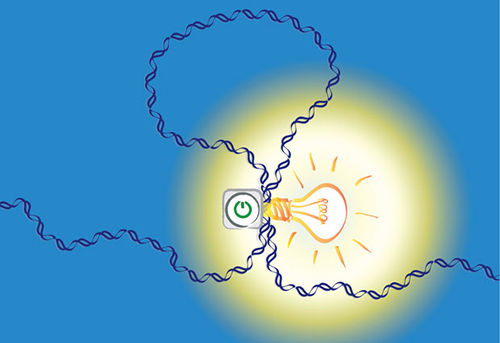Unrestricted self-renewal and the ability to form germline cells, sperm and ova, are the hallmarks of stem cells with the innate potential to become any cell in the body, a state termed pluripotency. Understanding the physical basis of pluripotency is key in regenerative medicine that aims to replace, engineer or regenerate diseases or aged cells.
Earlier studies have established that a tightly regulated protein called NANOG, is found in abundance with increased cellular capacity for reprograming and renewal and at miniscule levels with increased tendencies for spontaneous cellular differentiation and specialization. Moreover, human stem cells in culture can be coaxed into ground-state pluripotency—a state of naïve, untrained “stem-ness”—through enhanced NANOG expression. Yet, it has been unclear, until now, how NANOG accomplishes this.
In a new study from Baylor College of Medicine and collaborating institutions, scientists uncover mechanistic insights into the unique attributes of Nanog and its workings in activating pluripotency. These findings were published on April 28, 2022, in the journal Nature Cell Biology, in an article titled “NANOG prion-like assembly mediates DNA bridging to facilitate chromatin reorganization and activation of pluripotency.”
The researchers found NANOG’s “super stickiness” enables it to form large clumps at very low concentrations. These clumps interact with chromatin—DNA packaged into tight coils on protein scaffolds—to reshape its organization in a way induces pluripotency.
Senior author of the study, Josephine Ferreon, PhD, assistant professor of pharmacology and chemical biology and member of the Dan L Duncan Comprehensive Cancer Center at Baylor said, “Resetting specialized cells to a pluripotent state requires massive reorganization of the chromatin and changes in gene expression—turning on genes involved in pluripotency and turning off genes that specify specialized cells.”
Josephine Ferreon added, “Coordinated gene activation often requires bringing DNA elements that are far apart closer, to enable gene expression. We found that NANOG’s properties—its naturally floppy, flexible 3D shape and a C-terminal tail that is structurally akin to prion-like proteins—enable it to achieve this.”
Prions are a type of infectious misfolded protein that can transmit their misfolded shape onto normal variants of the same protein. The researchers found NANOG’s prion-like tail transitions spontaneously into a gel-like phase.
NANOG’s stickiness poses a problem since it form oligomers even at nanomolar concentrations. The researchers therefore resorted to using single-molecule Förster resonance energy transfer and fluorescence cross-correlation techniques to study NANOG and showed its oligomerization bridges DNA elements in vitro.
Using chromatin immunoprecipitation sequencing and Hi-C 3.0 in cells, the authors validated NANOG’s prion-like domain assembly is needed to recognize specific regions of DNA and bridge distant regions of chromatin. Hi-C, a benchmark tool to study genome organization, employs chromosome conformation capture (3C) to detect interacting chromatin pairs across the genome.
“In this study, we applied single molecule and fluorescence fluctuation microscopy techniques with which we can visualize whether two molecules interact with each other. The experiments were performed at very small concentrations, picomolar to nanomolar, where we can usually avoid aggregation and investigate aggregation-prone proteins,” said co-corresponding author, Allan Chris Ferreon, PhD, assistant professor of pharmacology and chemical biology at Baylor.
Allan Chris Ferreon added, “However, with NANOG, even at extremely low concentrations, we still detected aggregation. Nonetheless, we were able to show that NANOG aggregation is essential to its function as a master transcription factor and a mediator of the bridging of DNAs. This phenomenon may be unique to NANOG.”
“We think that this phenomenon is the reason why NANOG expression is key to the establishment of pluripotency. When NANOG’s level is low, cells are prone to differentiate, and when its level is high, the ground pluripotent state or ‘full reset’ is achieved and maintained,” said Josephine Ferreon.
The authors theorize, NANOG’s tendency for aggregation acts like a molecular glue that triggers and stabilizes bridged conformations of chromatin needed for pluripotency. It also explains its role as a molecular ‘hub’ that interactions with many regulatory proteins that detect, open and modify specific regions of chromatin.
Obtaining greater clarity on how NANOG with its prion-like tail works as part of a team of transcription factors, coactivators and epigenetic modulators that remodel chromatin architecture, remains the team’s goal in future investigations.



